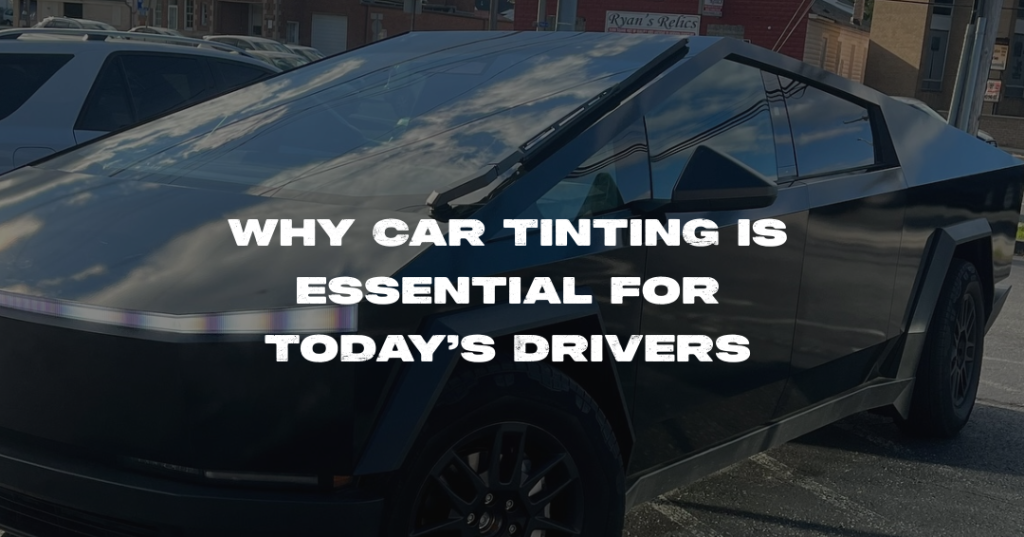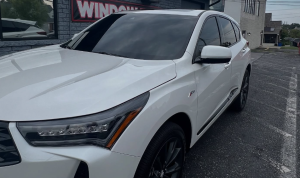Imagine hopping into your car on a sunny day, only to find the heat inside unbearable. More and more car owners are discovering the many benefits of car tinting to help solve just that. It’s not just about making your ride look sleek; it also significantly impacts comfort, security, and protection. Car tinting goes beyond aesthetics, providing practical advantages such as reducing glare, protecting your interior from harmful UV rays, and enhancing overall privacy. These benefits are why experts highly recommend professional tinting services. When you weigh the perks it brings against the cost, you’ll see why many consider it worth the investment. To learn more about why car window tinting may be right for you, explore this discussion on its true value.
Understanding Car Tinting
Car tinting is more than just an aesthetic upgrade for vehicles. It plays a crucial role in enhancing comfort, privacy, and protection against harmful sun exposure. For car owners, understanding the nature of car tinting and the materials used is key to making an informed decision.
What is Car Tinting?
Car tinting involves applying a thin film to the windows of a vehicle to reduce heat and glare from the sun. This process not only enhances privacy but also protects the car’s interior from fading caused by ultraviolet (UV) rays. Window tints come in various types, each offering different levels of shade and protection.
Common materials used in car tinting include:
- Dyed Window Tint: Offers a non-reflective finish, aiding in reducing glare and heat. It is often chosen for its ability to provide significant privacy and an affordable price point.
- Metalized Film: Contains metallic particles that can reflect heat and light, adding to the window’s glare-reducing properties.
- Carbon Tint Film: Known for blocking infrared light, it keeps interiors cooler and prevents upholstery from fading.
- Ceramic Window Tint: The top choice for those who want premium performance without metallic interference. It stands out for its superior heat reduction, UV ray blocking, and overall durability.
Each type of tint has its advantages, so understanding your specific needs—whether it’s heat reduction, aesthetics, or privacy—can guide you in selecting the right option effectively. For those curious about making an informed choice, reading more about tinting myths and facts can help clarify any misconceptions.
Benefits of Car Tinting
Car tinting isn’t just about making your vehicle look cool and stylish. It offers a range of benefits that many car owners might not immediately consider. From protecting your skin to making your ride more comfortable, car tinting can dramatically enhance your driving experience.
UV Protection and Skin Safety
Did you know that car tinting can significantly block harmful UV rays? The sun’s ultraviolet rays pose a risk not just to your skin but also to your car’s interior. Tinted windows can block up to 99% of these damaging rays, which helps in reducing the risk of skin cancer and preventing your car’s upholstery from fading. This added protection ensures that your vehicle maintains its value longer and keeps you and your passengers safe. For more on how car tinting can protect your vehicle, check out this resource.
Temperature Control and Comfort
Think of car tinting as your personal climate control assistant. Tinted windows help maintain a comfortable cabin temperature by reflecting solar energy away from your car. This means less reliance on air conditioning, which can save fuel and reduce emissions. On a scorching summer day, you’ll really appreciate how much cooler your car stays. For further insights on staying cool and comfortable, explore this discussion.
Enhanced Privacy and Security
Window tinting isn’t all about style; it also adds a layer of privacy and security. By making it harder to see inside your vehicle, tinting deters would-be thieves from targeting valuables left in plain view. Feeling secure in your car when parked is a peace of mind that every driver deserves. This aspect of car tinting is explored further here.
Improved Aesthetics
Let’s not forget how great car tinting looks. It adds an air of sophistication and elegance to your vehicle, enhancing its overall appeal. Whether you drive a luxury sedan or a reliable compact, tinting can give it a refined, cohesive look that turns heads on the road. It’s not just about hiding what’s inside; it’s about flaunting a sleek, modern exterior.
These benefits make car tinting a smart choice for any vehicle owner looking to improve both the function and aesthetics of their ride.
The Process of Car Tinting
Car tinting is a precise and intricate process that involves more than simply applying a layer of film to your windows. Each step ensures optimal results that enhance both the functionality and appearance of your vehicle. Below, we break down key considerations in choosing a service and maintaining your tinted windows.
Choosing a Professional Tinting Service
Selecting a reputable car tinting service is paramount to achieving results that will stand the test of time. Here are some tips to guide your choice:
- Research and Reviews: Look for services that come highly recommended. Check online reviews and testimonials to get a feel for customer satisfaction. A service with consistent positive feedback is a good sign of reliability.
- Experience and Expertise: Opt for professionals with a proven track record. A seasoned installer will provide a quality finish and know how to handle any challenges that might pop up during the installation. To understand the benefits of professional installation, consider reading about why DIY auto window tinting often falls short.
- Quality Materials: Ensure the service offers tints from reputable manufacturers. Quality film not only lasts longer but also offers better protection against UV rays and heat. A warranty often accompanies high-grade materials, offering peace of mind.
- Consultation and Customization: A good service will provide a thorough consultation to discuss your needs and preferences. They’ll offer advice on the various tint options and guide you through making the best decision for your vehicle. Explore how high-quality tinting can make a difference in your driving experience.
Post-Installation Care Tips
Once your car’s windows have been tinted, proper care will ensure they remain in top condition. Follow these tips for maintaining your new tint:
- Avoid Rolling Down Windows: During the curing process, which usually takes a few days, keep the windows closed to prevent the tint from peeling or shifting.
- Gentle Cleaning Products: Use a mild soap and water solution with a soft cloth or sponge to clean tinted windows. Avoid harsh chemicals and ammonia-based cleaners, which can damage the film. Learn more about maintaining window tint durability in this article.
- Regular Sunshade Use: Park in shaded areas or use a sunshade to prevent unnecessary exposure to intense sunlight, which can shorten the lifespan of the tint. This practice is just as crucial as applying wax to protect your car’s paint in harsh conditions, a strategy explored in this guide.
Taking these steps ensures that your newly tinted windows remain effective and retain their aesthetic appeal for years to come.
Car Tinting Laws and Regulations
Understanding the legal landscape of car tinting is essential for every vehicle owner. The rules surrounding window tinting can vary significantly from one state to another, which may affect your decision about how dark you want your car windows to be. Let’s dive into the specifics of these laws and dispel some myths along the way to make sure you’re cruising legally and informed.
Understanding Local Tinting Laws
Before tinting your car windows, it’s crucial to be aware of the specific regulations in your state. In Maryland, for instance, there’s a standard for how much light your tint must allow through. This is known as the Visible Light Transmission percentage (VLT%). Maryland mandates that passenger cars must have a VLT of 35% on front side windows, which means at least 35% of the visible light should pass through the window film.
Failing to comply with these laws can lead to fines, and in some cases, you might even be required to remove your tint. To avoid potential legal hassles, you should always ensure that the auto salon you choose is familiar with your state’s tinting laws. For specifics on how Maryland regulates window tinting compliance, check out this comprehensive guide.
Common Myths about Car Tinting
There are quite a few myths surrounding car tinting that can often mislead vehicle owners. Let’s set the record straight so you can make a well-informed decision:
- Myth #1: Tinted Windows Are Always Illegal
Contrary to popular belief, tinted windows are indeed legal, but under the condition that they comply with the state-specific guidelines on tint percentage. - Myth #2: Tint Increases Police Attention
Some people believe that having tinted windows can attract more attention from law enforcement. While police may be on the lookout for illegal tints, as long as you adhere to the legal standards, you shouldn’t have any issues. - Myth #3: Darker Tints Offer Better UV Protection
The effectiveness of UV protection doesn’t solely depend on the darkness of the tint. High-quality window films can block UV rays effectively, regardless of their shade. If you’re considering tinting, make sure to understand what you’re getting, as different films offer different benefits. For a deeper dive into misconceptions and truths, read more about car detailing myths that you should know.
By understanding these laws and dispelling common myths, you can make sure your tinting not only enhances your car’s look and comfort but keeps you on the right side of the law. Ensure every ride is as safe and legal as it is stylish.
Wrapping Up
As we come to the end of our deep dive into car tinting, it’s clear that this enhancement offers a wealth of benefits beyond just a chic, modern look. Think about it: car tinting plays a vital role in protecting your car, maintaining privacy, and even improving your driving experience. If you haven’t considered window tinting before, now might be the perfect time. But let’s break down the key takeaways one more time to make sure the advantages are firmly in mind.
Key Advantages Revisited
- UV Protection: Tinted windows can block up to 99% of harmful UV rays, safeguarding both your skin and your car’s interior. This protection ensures your vehicle maintains its aesthetic and practical value over time. For more information on this, explore how car tinting can be more than just style.
- Comfortable Driving: Tinting serves as your unsung climate control hero, reducing heat and glare, and ensuring a comfortable cabin temperature during the hotter months. It’s like having a sunshade that’s always working for you. Discover the specific benefits during cooler months in this discussion.
- Enhanced Privacy and Security: With window tinting, you can keep prying eyes at bay while your car enjoys a more secure and private atmosphere. This aspect is not just a bonus; in many cases, it serves as a deterrent against theft and vandalism. To understand why this is essential, check out why tinted windows are a must-have in 2024.
- Aesthetic and Value Boost: Beyond functionality, tinting gives your car a polished look, enhancing its curb appeal. Whether you want a subtle enhancement or a bold statement, there are options to suit every taste. The value it adds to your vehicle can’t be underestimated, particularly if you ever decide to sell or trade in your vehicle down the line.
These benefits underscore car tinting as a worthy consideration for any vehicle owner. If you’re interested in taking steps to protect your car’s interior and ensure longevity, learn more about preventing heat damage.
Reflecting on the Importance of Tinting
When you think about how much time you spend in your car, it makes sense to invest in something that improves both comfort and safety. So, what’s holding you back? Whether you’re motivated by protecting your investment, enhancing your driving experience, or simply upgrading your car’s look, tinting is a practical addition. Consider this the next time you’re sitting in traffic, with the sun glaring through your windows—wouldn’t a cooler, more private ride make all the difference?





